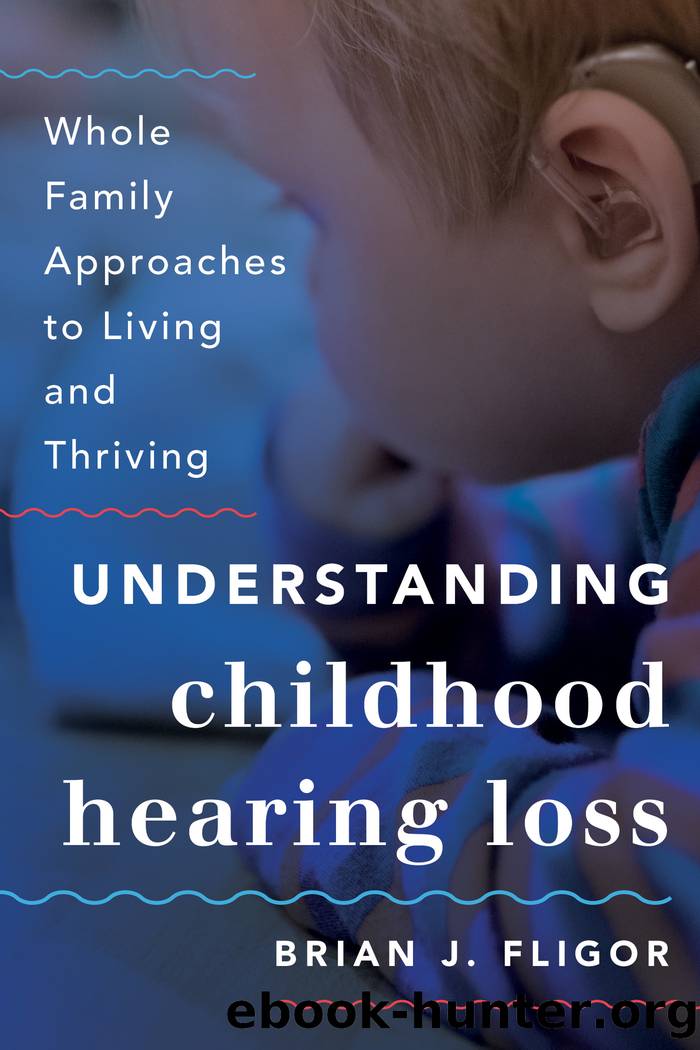Understanding Childhood Hearing Loss by Brian J. Fligor

Author:Brian J. Fligor
Language: eng
Format: epub
Tags: undefined
Publisher: Rowman & Littlefield Publishers
Published: 2012-09-15T00:00:00+00:00
Baha: Bone-anchored Osseointegrated Devices
Another kind of device is also available for children with permanent conductive hearing loss in both ears, or hearing loss in just one ear: a bone-anchored hearing system (often referred to as a âBahaâ because it used to be called a âbone-anchored hearing aidâ). The name of this system was changed because the term âhearing aidâ created problems getting insurance companies to cover the cost of the device and related surgical and audiological services (historically, insurance companies donât cover the cost of hearing aids!). Sound can be delivered to the inner ear (cochlea) through the bones of the head: hold a tuning fork in your teeth or behind your ear and itâs obvious. Bone-anchored hearing systems take advantage of this fact to help people hear when they have permanent conductive hearing loss, and they canât otherwise use hearing aids that go in the ear. If a person doesnât have ears or ear canals, conventional hearing aids canât be used.
Bone-anchored hearing systems include a very small titanium screw that is surgically implanted into one of the bones of the skull above and behind the ear by an ENT surgeon. Connected to the top of this titanium screw is an âabutmentâ that juts out through the skin of the scalp. About three months after the surgery to implant the titanium screw, the bone heals around the implant enough that the implant is now osseointegrated (fused into the bones of the skull). An externally worn sound processor attaches to the abutment; this sound processor has a microphone and the electronics for processing sound, which is programmed by an audiologist. Instead of the sound being sent through the ear canal to the eardrum as with conventional hearing aids, the sound is sent through the bones of the skull to the cochlea where the sound is heard.
While the FDA has approved the surgery for bone-anchored hearing systems in children five years and up, the age at which a child can have the titanium screw implanted varies, and depends on how each childâs skull is forming. If the skull is too thin where the screw needs to be implanted, the child isnât a candidate (yet . . . maybe she will be as she gets older). Regardless of the age when the surgery can be performed to implant the screw, these bone-anchored hearing systems can be mounted onto a soft headband (a âsoftbandâ) with the external sound processor held against the skull. The sound processor sends the sound vibrations through the skull where they are picked up by the cochlea, in much the same way it would if it were mounted onto the abutment of an osseointegrated screw. Some of the downside to the sound processor being mounted onto a softband is that the range from softest to loudest sound that can be delivered is smaller, and the range of pitches that can be delivered isnât as broad as when the processor is mounted onto an osseointegrated post and abutment. While these are
Download
This site does not store any files on its server. We only index and link to content provided by other sites. Please contact the content providers to delete copyright contents if any and email us, we'll remove relevant links or contents immediately.
Spare by Prince Harry The Duke of Sussex(5143)
Machine Learning at Scale with H2O by Gregory Keys | David Whiting(4264)
Fairy Tale by Stephen King(3313)
Will by Will Smith(2877)
Hooked: A Dark, Contemporary Romance (Never After Series) by Emily McIntire(2529)
The Bullet Journal Method by Ryder Carroll(2528)
Rationality by Steven Pinker(2331)
Can't Hurt Me: Master Your Mind and Defy the Odds - Clean Edition by David Goggins(2280)
It Starts With Us (It Ends with Us #2) by Colleen Hoover(2261)
Friends, Lovers, and the Big Terrible Thing by Matthew Perry(2186)
The Becoming by Nora Roberts(2159)
Love on the Brain by Ali Hazelwood(2028)
HBR's 10 Must Reads 2022 by Harvard Business Review(1822)
A Short History of War by Jeremy Black(1820)
The Strength In Our Scars by Bianca Sparacino(1819)
Leviathan Falls (The Expanse Book 9) by James S. A. Corey(1705)
A Game of Thrones (The Illustrated Edition) by George R. R. Martin(1671)
515945210 by Unknown(1645)
Bewilderment by Richard Powers(1585)
